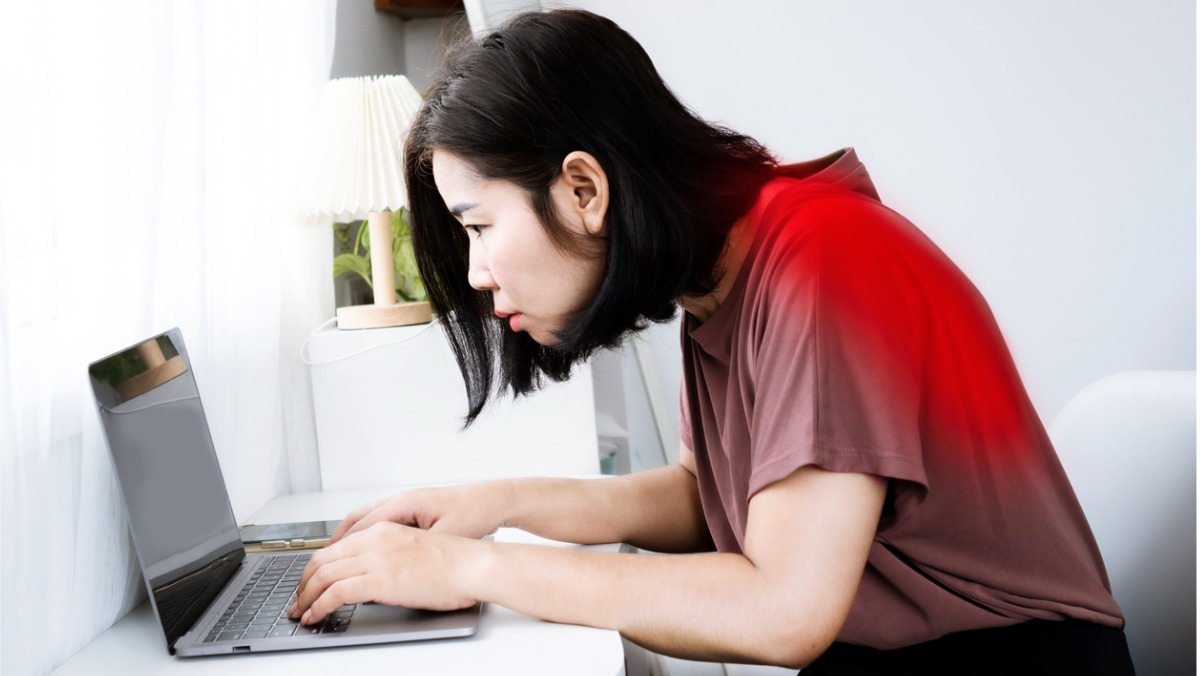
No one wants to look like an elderly person before their time. If you’re at risk of Dowager’s Hump, widely referred to as neck hump, that’s exactly what can happen. Office workers are some of the most at risk of a Dowager’s Hump, but a few simple changes and exercises can reduce your risk.
What is Dowager’s Hump?
Dowager’s hump is an excessive curvature of the spine that makes the upper back appear rounded or hunched. A dowager is a widow or widower who holds property derived from their deceased spouse. Therefore, dowager’s hump isn’t a medical term. The medical term is known as kyphosis, which is common in elderly people because the curvature of the spine increases naturally with age. However, kyphosis can occur at any age.
The symptoms of kyphosis include:
- Pain in the rounded back/hump
- Fatigue
- Poor strength
- Reduced mobility
- Tenderness of the spine
In severe cases of kyphosis, the symptoms can include chest pain and breathing difficulties, with some people experiencing loss of bowel and bladder control.
There are a few different types of kyphosis:
- Postural kyphosis - caused by poor posture, weak bones, or fractures
- Congenital kyphosis - occurs during a baby’s spine development
- Metabolic kyphosis - when a condition affects the formation and density of bone
- Scheuermann's kyphosis - spinal disc herniation known as Schmorl’s nodes
Causes of Dowager’s Hump
There are several different causes for Dowager's Hump, but bad posture is the most common. Office workers are at increased risk because sitting for long periods causes weakened upper back muscles and tight neck and hip flexor muscles. But it’s not just office workers who are at increased occupational risk.
Workers who spend long periods in bent positions, such as welders and shearers, are likelier to develop the condition. Degenerative disc disease and vertebral fractures increase the risk, as well as hardening of ligaments along the spine. Genetics can also play a part in some people.
Exercises for When You’re at Your Desk
There’s no need to wait to get home to exercise. Implement these simple exercises at your desk throughout the day to help you avoid kyphosis.
#1 Chin Tucks
Place two fingers at the bottom of your chin, then tuck your chin in and gently retract your head backwards. Hold for 3-5 seconds, then relax and repeat for two sets of 10 repetitions.
#2 Shoulder Tucks
In an upright posture, pull your shoulders back, squeeze your shoulder blades together as tight as possible, and hold for 5-10 seconds.
#3 Back Stretch
Looking at the ceiling, push your chest out and arch your spine. Inhale and exhale.
#4 Shoulder Shrug
With arms at your side, lift the shoulders towards your ears, then hold for 3 seconds before gently releasing your shoulders back down.
#5 Hip Opener
If you feel your hips are tight, start with both feet on the floor. Bend your right leg and place your ankle on your left thigh, making a triangle. Inhale and exhale, then repeat on the other side.
More Tips for Avoiding Dowager’s Hump
Maintaining good posture is the best way to prevent kyphosis. Throughout the day, while you’re sitting at your desk, remind yourself to sit back in the chair with feet flat on the floor or footrest, shoulders back, and head directly over your body, not in a forward position.
Regular exercise is beneficial for keeping bones and ligaments that support the spine strong and healthy. Ensure you get at least 30 minutes of exercise daily for good bone health. If you have a sedentary job, try spending more of your leisure time on your feet rather than sitting in the lounge. Go for a walk, do some gardening, or simply stand while you’re on the phone. Alternating your sitting and standing position as often as possible reduces the load on your hips and spine.
On another note, eating a diet that’s high in calcium, such as leafy greens, seeds, beans, and lentils, can support bone strength and prevent osteoporosis and continued spinal compression fractures. Speak to your doctor about taking a supplement if you can’t get enough calcium or vitamin D from your diet.
Check out our range of products that help improve posture at your desk, including office chairs, footrests, headsets, and standing desks. If you need assistance finding the right products, please call Ergolink on (08) 9240 7066, visit our website, at our showroom, or contact us online.